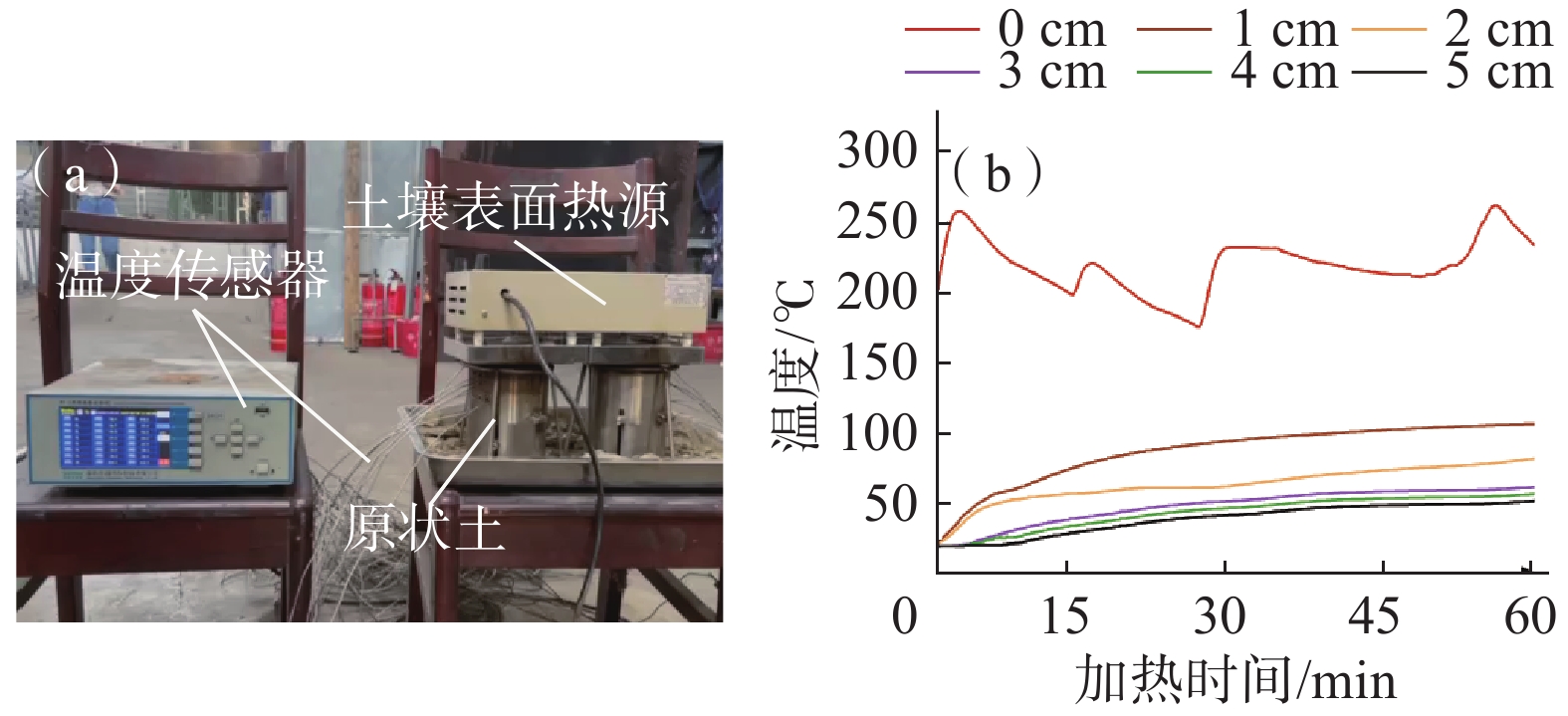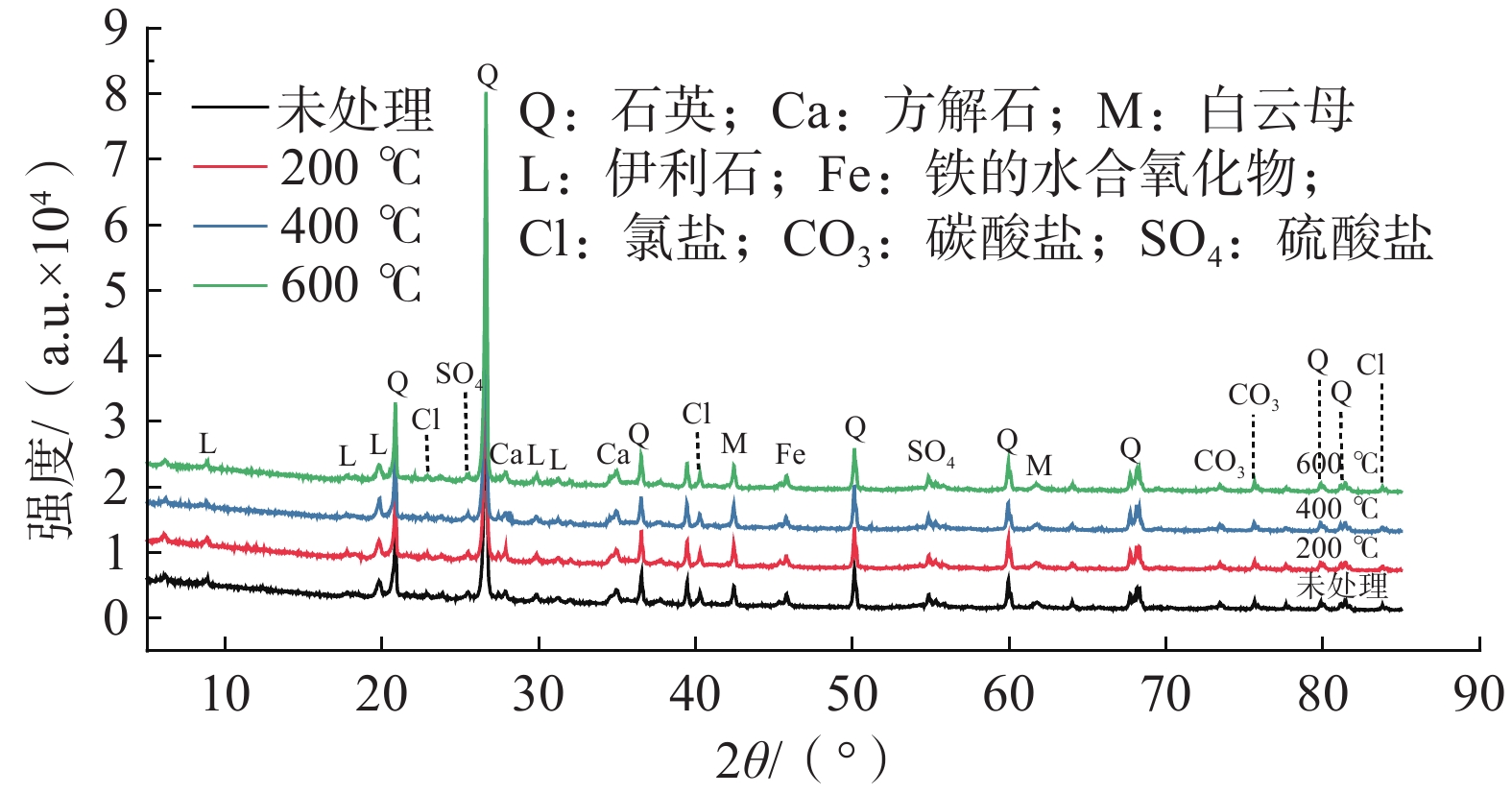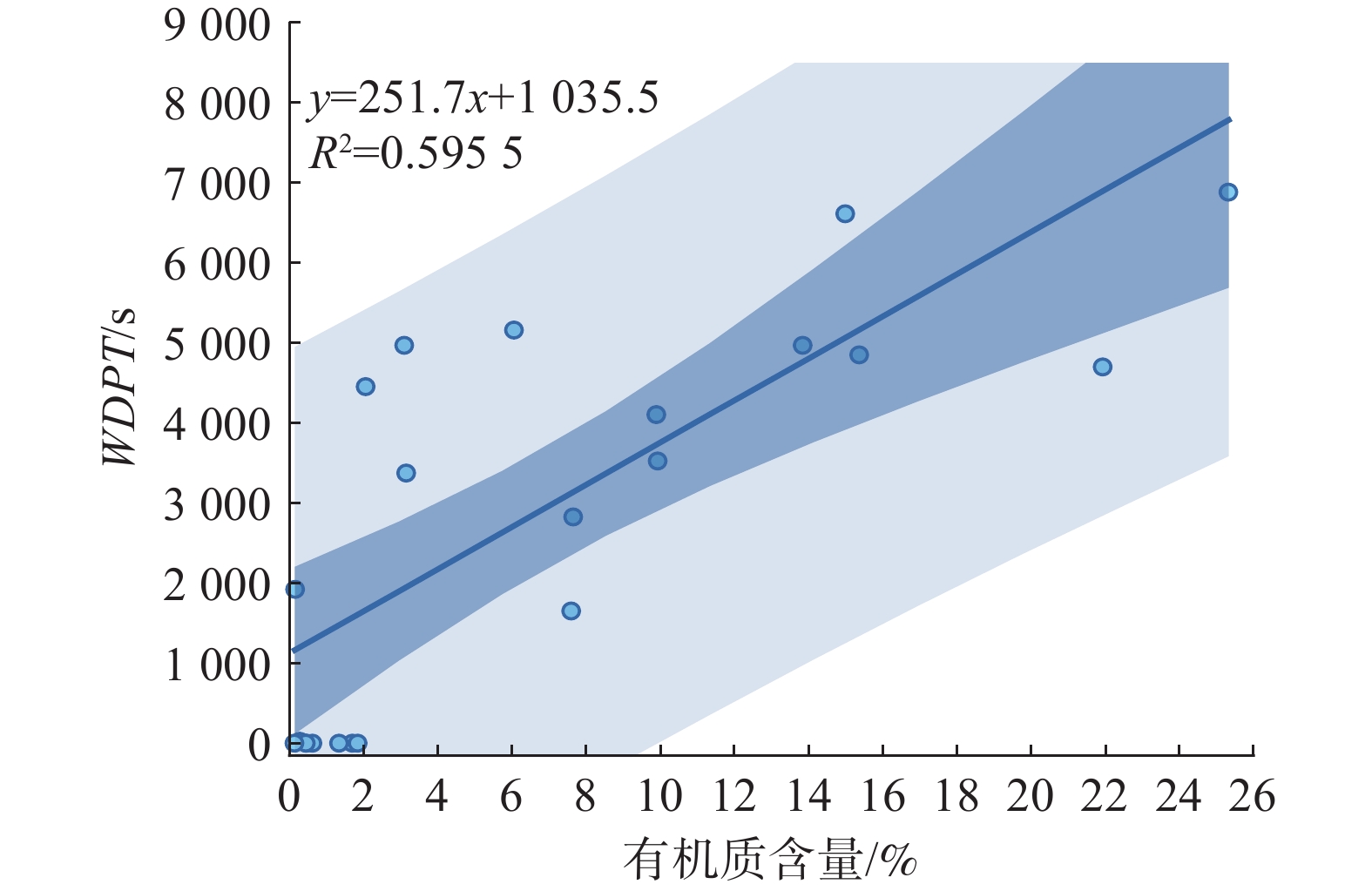Study of factors influencing soil water repellency under simulated forest fire
-
摘要:
云南松作为西南山区主要树种,富含树脂易引发森林火灾,林火后火烧迹地土壤通常会产生斥水性,导致火烧区地表径流和侵蚀加剧,最终诱发火后泥石流。为探究土壤斥水性影响因素及形成机制,以四川省冕宁县腊窝乡松林区未火烧土壤为研究对象,采用室内模拟火烧试验,考虑松脂含量、土壤角砾含量、初始有机质含量、加热温度和加热时间等因素设计正交试验,利用X射线衍射和扫描电镜分析土壤化学元素和微观结构变化,研究林火对土壤斥水性的影响。结果表明:林火后各因素对土壤斥水性影响程度排序为初始有机质含量>加热温度>加热时间>松脂含量>角砾含量;初始有机质含量、加热温度对土壤斥水性的影响极显著;加热时间、松脂含量影响显著;角砾含量影响不显著。各因素均能引起土壤中有机化合物变化,进而影响土壤斥水性。具体表现:适度火烧后(温度≤400 °C)土壤中有机质化合物发生化学变化,形成致密的疏水有机质薄膜,覆盖于矿物颗粒表面并充填于颗粒间隙,导致土壤斥水性增强;过度火烧(温度> 400 °C)导致有机质被消耗,土壤微团聚体结构被破坏,矿物颗粒呈松散堆叠状态,土壤斥水性减小。研究结果可为松林区火烧迹地土壤侵蚀模式和火后泥石流形成机制提供依据。
Abstract:Yunnan pine, as the prominent arboreal species in the southwestern mountains, exhibits abundant resin content and displays susceptibility to forest fires. Soil in fire-affected areas typically exhibits water repellency after a forest fire, leading to increased surface runoff and erosion within the affected area, ultimately triggering post-fire debris flows. In order to investigate the influencing factors and formation mechanism of soil water repellency, unburned soils in the pine forest vegetation area of Lawo Township, Mianning County, Sichuan Province was selected as the research project. Indoor simulated fire experiment were conducted, and orthogonal experiments were designed considering factors such as turpentine content, soil debris content, initial organic content, heating temperature, and heating period. X-ray diffraction and scanning electron microscopy were used to analyze changes in chemical elements and microstructure, studying the impact of forest fires on soil water repellency. The results showed that the degree of influence of various factors on soil water repellency was ranked as follows: initial organic matter content, heating temperature, heating period, pine resin content, and debris content. The initial organic matter content and heating temperature on soil water repellency was highly significant, while heating time and pine resin content was significant, and debris content had no significant impact. All factors could cause changes in organic compounds in the soil, thereby affecting soil water repellency. Specifically, after moderate burning (temperature ≤ 400 °C), organic compounds in the soil underwent chemical changes, forming dense hydrophobic organic matter films covering the surface of mineral particles and filling the interstitial space of the particles, resulting in enhanced soil water repellency. Excessive burning (temperature > 400 °C) resulted in the consumption of organic matter, the destruction of soil microaggregate structure, loose stacking of mineral particles, and a decrease in soil water repellency. The research results can provide a basis for the soil erosion pattern of soil in pine forest fire-affected areas and the formation mechanism of post-fire debris flows.
-
Keywords:
- soil water repellency /
- burned area /
- pine forest /
- chemical properties /
- microstructure
-
0. 引言
森林火灾后火烧迹地土壤会产生斥水性[1]。这种现象会导致土壤入渗速率降低,地表径流增强,土壤受侵蚀的风险升高,进而导致火烧迹地火后泥石流易发性和一次冲出规模增加[2]。
关于土壤斥水性产生或增强的内在影响机制,Wu等[3]、Mao[4]和Thomaz等[5]进行了大量研究,一般认为火烧会引起土壤有机质发生化学反应,或改变土壤结构,进而产生或增加土壤斥水性。Poesen等[6]进一步指出土壤中的角砾含量会影响土壤的导热系数和蓄热能力,进而影响土壤斥水性。Doerr等[7]则发现桉树林、松树林下土壤中富含的蜡、芳香油等有机质化合物会显著增强土壤斥水性。通过对西南山区典型火烧迹地实地调查也发现(西南山区近90%的火烧迹地植被类型以松树为主),松树中的油脂浸入到土壤后会显著影响土壤斥水性[1,8 − 9]。并且土壤的结构组成,细粒(<2 mm)和粗粒含量(2~5 mm)也在一定程度上影响土壤斥水性的强度[10]。
火烧温度与持续时间是影响土壤斥水性的主要外在因素[9]。根据王严等[1]研究发现,土壤斥水性随火烈度的增大而增大,且火烧对土壤斥水性的最大影响深度为3 cm,而对土壤渗透性的影响深度则不超过4 cm。Debano等[11]研究表明,森林火灾期间最高温度在500~800 °C,持续时间从几分钟到数小时不等。Gimeno-Garcıá等[12]通过现场测量,得出火灾期间温度集中分布在322°C~543 °C,最高温度可达677 °C。何诚等[13]则指出,明火扑灭后土壤枯枝落叶层及腐殖质仍以阴燃的方式持续燃烧1 h以上,最高温度达600 °C左右。由于现场实测温度变化差异大,且土壤斥水性测量结果由诸多因素共同导致,很难定量分析各温度和持续时间对土壤斥水性的影响程度。因此,Zavala等[14]、Certini等[15]、Jordan等[16]和Wu等[3]分别采用了室内试验定量探究了火烧温度和持续时间对土壤斥水性的影响。
由于土壤斥水性形成机制复杂且影响因素众多,目前国内关于林火如何影响土壤斥水性以及定量评价各影响因素对土壤斥水性影响程度的研究尚不足,关于土壤斥水性与火后泥石流响应机制研究仍较为缺乏。2022年2月19日四川省冕宁县发生森林火灾,林区植被主要为云南松。为定量分析各因素对土壤斥水性的影响,充分揭示土壤斥水性的形成机制,选择该区域的未火烧区土壤样本,采用正交试验设计,以马弗炉进行室内火烧模拟试验[4]。结合火烧迹地现场试验数据,充分考虑松脂含量、土壤角砾含量、初始有机质含量、火烧温度和火烧持续时间,探究其对土壤斥水性的影响。并利用X射线衍射和扫描电子显微镜分析了土壤的化学元素和微观结构变化,从微观角度解释土壤斥水性变化的原因,为松林火烧迹地土壤侵蚀模式及火后泥石流形成提供依据。
1. 研究区植被及土壤概况
研究区位于四川省凉山彝族自治州北部,地处横断山脉东侧、川西南山地与川西北高原过渡地带,气候类型为亚热带季风气候,冬季温暖干燥,夏季雨热充足,年平均气温16 °C,年均降水量
1014 mm。植被类型丰富,以针叶林为主,阔叶林分布次之。常见树种为云南松,其覆盖面积占总植被覆盖面积41%。研究样本为松林下土壤,土壤类型主要为壤质砂土,基岩以千枚岩为主。实验室测得表层土天然密度约0.91 g/m3,含有较多的砾石。土壤呈酸性,pH约为5.53,枯枝落叶层较厚,有机质含量丰富,其中0~2 cm土层有机质含量约为13%。2. 取样与试验
2.1 试样采集
根据遥感解译和野外调查,确定了火烧迹地火烈度区,见图1。以松林下未火烧区土壤为对象,取样部位的地形坡度、植被类型和土壤性质均类似。采用随机区组的试验设计,设置10 m×10 m的采样单元10个,每块单元采取五点取样法。取样前用刷子清理表层枯枝落叶、小树枝等,缓缓施压环刀(直径10 cm、高10 cm)直至完全嵌入土体,用铲子将环刀与周边土一起铲除后削去多余土体,获取50组原状土样保存并密封带回实验室[15]。将每组土样按0~1 cm、1~2 cm、2~3 cm和3~4 cm分层,为消除土样不均匀误差对土壤斥水性的影响规律,将各层土样充分混合均匀后,去除其中的小树枝和角砾,这样便获得了4个有机质含量水平的土样,取样位置见图1。
2.2 试验方法
2.2.1 正交试验
为了提高试验效率,本文引入正交试验设计,结合前人研究及野外调查[5 − 7],探究松脂含量、土壤角砾(土体中直径为2~5 mm的粗粒成分)含量、初始有机质含量、加热温度和加热时间共5种因素对土壤斥水性的影响。本次实验包括5个因子,其中土壤有机质含量考虑4个试验水平,其余各因素考虑5个试验水平,采用正交试验数组L25(4×54),可进行4+5×4+1=25次试验来评估影响因素对指标的影响程度。试验方案和试验结果见表1。
表 1 正交实验结果Table 1. Orthogonal experimental results编号 加热温度/°C 加热时间/min 初始有机质含量/% 松脂含量/g 角砾含量/% WDPT/s 有机质含量/% 土壤斥水性变化
对照组→试验组1 100 5 <5 0 0 35 7.61 亲水→轻度 2 100 15 5~10 0.2 20 3956 11.90 轻度→极端 3 100 30 10~15 0.5 5 5257 21.94 强烈→极端 4 100 60 >15 1 40 4122 18.37 强烈→极端 5 100 120 <5 2 10 3204 15.00 亲水→严重 6 200 5 >15 5 20 8038 25.32 强烈→极端 7 200 15 <5 0 5 3584 7.66 亲水→严重 8 200 30 <5 0.2 40 1270 6.95 亲水→严重 9 200 60 5~10 0.5 10 4020 17.94 轻度→极端 10 200 120 10~15 1 0 5538 22.84 强烈→极端 11 400 5 5~10 1 5 6119 10.33 轻度→极端 12 400 15 10~15 2 40 9530 29.07 强烈→极端 13 400 30 >15 0 10 3397 9.06 强烈→严重 14 400 60 <5 0.2 0 11 1.70 亲水→轻度 15 400 120 <5 0.5 20 2300 5.84 亲水→严重 16 600 5 <5 0.5 40 3258 8.16 亲水→严重 17 600 15 <5 1 10 2569 6.06 亲水→严重 18 600 30 5~10 2 0 123 0.45 轻度→强烈 19 600 60 10~15 0 20 1 0.28 强烈→亲水 20 600 120 >15 0.2 5 1 0.16 强烈→亲水 21 800 5 10~15 0.2 10 5225 23.10 强烈→极端 22 800 15 >15 0.5 0 132 1.34 强烈→强烈 23 800 30 <5 1 20 1 0.62 亲水→亲水 24 800 60 <5 2 5 1 0.15 亲水→亲水 25 800 120 5~10 0 40 1 0.46 轻度→亲水 2.2.2 模拟火烧试验
火烧迹地土壤斥水性实测值是诸多环境因素共同作用下的综合指标,很难准确反映单个因素影响土壤斥水性的重要程度[11]。因此,本文以现场调查结果为基础,进行室内火烧模拟,定量评价各因素对土壤斥水性的影响。
在室内分析过程中,首先通过将热源放置在原状土样表层的形式,模拟了火烧迹地土壤现场的受热情况,见图2(a)。探究了温度在土层内部的传递特点,并确定温度影响范围(温度仅影响土壤表层0~4 cm,与实测结果一致[1])以及各土层温度的变化特征,见图2(b)。但模拟过程中表层土壤温度变化范围极大(±150°C),不能保持恒温。此外,原状土样内的有机质含量、角砾含量以及松脂含量等均不能定量控制,仅反映了土样的实际水平,这与本文的研究目的不符。
根据Wu等[3]、Thomaz等[5]和Bodi等[17]研究结果,使用马弗炉对筛分土样进行控温处理,是分析土壤斥水性与各环境因素之间定量关系的有效手段。因此本文借鉴Wu等[3]的试验方法,通过马弗炉加热土壤筛分样的形式,探究各影响因素与土壤斥水性的定量关系。具体试验步骤为:(1)分层获取直径<2 mm的土壤筛分样(分厘米均匀混合),并于室内(约25°C,50%湿度)自然条件下风干一周[7],并测量每层土壤斥水性作为对照组;(2)根据正交试验设计内容(表1),预处理各组样品(控制土壤有机质含量、松脂含量、角砾含量等),获得25组土样;(3)每组土壤取20 g,作为试验组,并置于底座为10 mm2釉面陶瓷坩埚中,根据前人对野外林火温度和时间的监测[11 − 13],设置温度为100~800°C,加热时间分别为5、15、30、60、120min,于马弗炉中进行恒温加热;(4)加热完的试验样品,于室内自然条件下风干一周然后测试其斥水性。
2.2.3 土壤性质测试方法
土壤斥水性使用水滴渗透时间测试(water drop penetration time,WDPT)评估,热处理后土样过筛获得<2 mm粒径土样,将其平铺在玻璃载玻片上,用100 g砝码施压约2 min,将去离子水(大约0.5 μL/滴)滴至土样表面,记录水滴完全渗透的时间,每个大约10滴,取10次测试结果的平均值作为土样的WDPT值[18]。根据Doerr等[7]提出的分类等级标准,将土壤斥水性划分为5类:亲水性(<5 s),轻度斥水性(5~60 s),强烈斥水性(60~600 s),严重斥水性(600~
3600 s)和极端斥水性(>3600 s)。有机质含量测试采用烧失量法(loss on ignition,LOI)[19],风干土样过0.25 mm筛网,将筛分后土样放入坩埚中(约5 g),记录坩埚重量(m0)和样品重量(m1)。将坩埚置于马弗炉500°C烘烤4 h,取出坩埚冷却后测量样品重量(m2),土样有机质含量为:
(1) 为了揭示林火影响土壤斥水性的形成机制,本研究通过扫描电镜和X射线衍射分析了不同火烧程度下土壤的微观结构、化学元素和矿物成分变化。
2.3 统计学分析
本研究中采用SPSS 22.0软件进行统计分析,通过极差和方差分析判断因子对指数的影响大小,采用p统计量来表示各因素的影响程度,在0.05水平上设置有统计学意义的阈值。采用Jade软件分析土壤中无机矿物和无机盐,Image J软件计算土壤孔隙率。
3. 结果与分析
加热后的土壤样品见图3,土壤中有机质含量较高时土壤呈黑色,有机质含量较少时呈浅棕色甚至红色,这与有机质的焦化、氧化有关[20]。正交试验结果见表1,并对结果进行计算分析,极差分析可以直观比较影响因素对结果的影响大小,主效应图用以评估每个影响因素对结果的影响程度,方差分析评估各影响因素对结果的影响显著性大小。
3.1 极差分析
对上述正交试验结果进行极差分析,初步确定各因素对土壤斥水性的影响大小,如表2所示。加热温度(A)、加热时间(B)、初始有机质含量(C)、松脂含量(D)、角砾含量(E)的R值(R值越大表明该因子对指标的影响越大)分别为
3418 、2904 、3587 、2776 、2515 ,说明各因素对土壤斥水性的影响大小:初始有机质含量>加热温度>加热时间>松脂含量>角砾含量。表 2 极差分析结果Table 2. Extreme variance analysis results水平 A B C D E 1 3315 4535 1523 1404 1168 2 4490 3954 2844 2093 2992 3 4071 2009 5110 2793 3683 4 1191 1631 3138 3670 2659 5 1072 2009 / 4179 3636 R 3418 2904 3587 2776 2515 排序 2 3 1 4 5 均值主效应见图4,加热温度在100~400 °C时,土壤斥水性逐渐增强,200 °C时达到最强。随着温度进一步升高,WDPT逐渐下降,当温度为800 °C时WDPT趋近于0。说明适当的加热温度使土壤斥水性增强,温度过高土壤斥水性减弱甚至消失[16];加热时间在30 min前土壤斥水性逐渐降低,超过30 min土壤斥水性随加热时间增加变化不大。加热前30 min是土壤斥水性发生剧烈变化的时期,加热到60 min及以后土壤斥水性已相对稳定[18];随着初始有机质含量升高,土壤斥水性先增加后降低,一定程度上有机质含量与土壤斥水性呈正相关,但与有机质种类密切相关[11]。当初始有机质含量>15%时,土壤斥水性降低,主要由于该土壤层含有较多枯枝落叶和腐殖质,燃烧成灰烬或挥发,缺少疏水性有机质[21];随松脂含量的增加土壤斥水性呈逐步上升趋势,脂类化合物对于土壤斥水性有很大影响,是主要的疏水物质[22];角砾含量为0~10%时,土壤斥水性随角砾含量增加而增加,超过10%时土壤斥水性随角砾含量变化无明显规律。土壤中的角砾起到保温和热传递作用,含量10%时土壤斥水性最强,角砾含量继续增多,可能岩石与岩石有更多接触面积,而与土颗粒接触面积小,因此角砾含量继续增多时,土壤斥水性并不持续增强。
3.2 方差分析
为进一步分析不同因素对土壤斥水性的影响程度,采用SPSS软件对正交试验结果进行方差分析。结果见表3,加热温度(A)、加热时间(B)、初始有机质含量(C)、松脂含量(D)、角砾含量(E)的p值分别为:0.010、0.024、0.009、0.041、0.061。
表 3 方差分析结果Table 3. Analysis of variance (ANOVA) results来源 F p 加热温度(A) 12.167 0.010 加热时间(B) 7.478 0.024 松脂含量(C) 5.751 0.041 角砾含量(D) 4.670 0.061 初始有机质含量(E) 12.271 0.009 当p值小于0.05时,认为该因素对目标变量的影响是显著的;小于0.01时,认为该因素对目标变量的影响是极显著的。以上结果表明,初始有机质含量、加热温度对土壤斥水性影响极显著,松脂含量、加热时间对土壤斥水性影响显著,角砾含量对土壤斥水性无显著影响,与极差分析结果一致。
3.3 化学成分变化
根据正交试验结果可知,当设置环境条件为加热温度200 °C、加热时间5 min、初始有机质含量10%~15%、角砾含量10%和松脂含量10%时土壤产生的斥水性最强,其中角砾含量影响不显著。为了探讨土壤斥水性产生及影响机制,本文根据试验结果分别采用200 °C、400 °C和600 °C对初始有机质含量为10%~15%和松脂含量0%、角砾含量0%的土样进行加热处理,加热时间统一为5 min,并选取未加热样品作对照组,样品处理前后的有机质含量及WDPT值如表4。将处理后的样品进行X射线衍射和扫描电镜分析。需要强调的是,根据吴小雨等[23]研究,表明松脂含量是通过影响土壤有机质中疏水化合物占比,进而影响土壤斥水性。而正交试验结果也表明松脂含量并不是土壤斥水性最重要影响因素,为了着重探讨初始有机质含量随温度的变化过程,排除因添加松脂造成的土壤斥水性产生机制误判,固将松脂含量设置为0%。
表 4 样品处理前后的有机质含量及WDPTTable 4. Organic matter content and WDPT before and after sample treatment土壤样品 平均WDPT/s 有机质含量/% 未处理 3319 12.5 200°C 6065 10.6 400°C 8702 9.3 600°C 1652 5.8 通过X射线衍射分析火烧前后土壤化学元素,结果显示(图5)土壤中主要化学元素为O、Si、C、Al、Fe和K。土壤样品加热后O、Si、Al、Fe和K元素相对含量均有提高,C元素相对质量随着燃烧温度升高明显降低。这是由于火烧使有机物发生燃烧、炭化或分解等作用,有机碳被氧化成CO2或其它气体,从而导致C元素含量减少,而其他元素相对含量增加[23]。
土壤样品中主要含有无机矿物质、有机质和各种盐(如氯盐、碳酸盐和硫酸盐等)。根据XRD图谱(图6)分析,土壤中无机矿物以及各种盐类含量基本不随温度而变化。根据表4,未处理的土壤样品有机质含量为12.5%,加热200 °C时有机质含量减少到10.6%,加热400 °C时有机质含量减少到9.3%,加热到400 °C时有机质减少到5.8%。结合图4结果,表明温度对土壤中有机化合物的影响较大,C元素的消耗代表了有机化合物的消耗量。
3.4 土壤微观特征
根据化学元素分析,受试土壤中主要的化合物为无机矿物质和有机质,根据杜娟[20]表明,矿物颗粒表面质地光滑,而有机质聚集体表面粗糙呈现胶状或粒状,在土壤团聚体中是主要的胶结物质。如图7所示,未火烧土壤团聚体内部,可见质地光滑呈薄片状的矿物颗粒,在矿物颗粒表面或孔隙间依附有表面粗糙的有机化合物颗粒,有机化合物主要呈点状散布于矿物颗粒表面,矿物颗粒间隙较大,具有一定的结构形态。当以200 °C加热5 min后,有机质开始逐渐包裹在矿物颗粒表面,矿物颗粒之间被胶状有机质化合物连接。400 °C加热5 min后,土壤矿物颗粒表面有机质包裹程度进一步增大,矿物颗粒之间被有机质填充。当温度加热到600 °C时,矿物颗粒表面有机质覆盖面积明显减少,颗粒间起胶结作用的有机质也显著减少,表明高温微团聚体(矿物颗粒与有机质的聚集体)结构被破坏,矿物颗粒呈松散堆积状态。
为了准确刻画各火烧温度下土壤微观结构及孔隙特征,对SEM图片进行了预处理,以降低误差。SEM图片处理通过导入Image J软件选用最大类间方差法进行图像二值化处理(图8),然后使用颗粒分析工具进行孔隙和颗粒形态分析。
土壤样品矿物颗粒分析结果(表5)显示,未火烧~400 °C火烧下的土壤样品随着加热温度增加,矿物颗粒平均粒径逐渐增大,微团聚体粒径从未火烧的2.52 μm,增加到400 °C的3.59 μm;颗粒平均面积从未火烧的2.54 μm2,增加到400 °C的3.48 μm2;颗粒的形状系数从未火烧的0.85,降低到400 °C的0.61。结合图5所示表明该过程土壤有机质变化导致了土壤颗粒的增大,形状更不规则。而600 °C下微团聚体颗粒平均粒径和平均面积降低(比未火烧更低),平均形状系数变大,说明微团聚体结构被破坏,矿物颗粒表面或间隙中的有机质被消耗,呈松散堆积排列,颗粒更均匀。
表 5 土壤样品微团聚体颗粒分析结果Table 5. Analysis results of soil samples microaggregates particles火烧程度 平面粒径/μm 平均面积/μm2 平均周长/μm 平均形状系数 未火烧 2.52 2.54 6.12 0.85 200 °C 3.18 2.87 6.96 0.74 400 °C 3.59 3.48 8.48 0.61 600 °C 1.58 1.76 4.89 0.92 土壤样品微观结构的孔隙分析结果(表6)显示,未火烧~400 °C火烧下,微团聚体平面孔隙率从未处理土壤中的44.93%降低到400 °C的30.19%,相应的平均面积和周长也分别有所降低,孔隙的形状系数降低,孔隙更加倾向于不规则排列。而600 °C时,平面孔隙率、孔隙面积和周长均增大,且向着均匀化排列(孔隙的形状系数从400 °C的0.65增加到600 °C的0.83)。总体而言,随着加热温度增加,土壤孔隙率逐渐减小,土壤孔隙面积减小,说明适度火烧使土壤逐渐趋向规则、紧密化排列。土壤中的有机质可能发生热解、焦化等作用,黏结在土壤颗粒表面或存在于土壤颗粒间隙,造成孔隙度减少[5]。温度过高的情况下,有机质被消耗,导致土壤孔隙率减小,土壤结构坍塌,导致原先存在的孔隙塌陷或消失,造成孔隙平均面积减小[24]。
表 6 土壤样品孔隙分析结果Table 6. Results of pore analysis of soil samples火烧程度 平面孔隙率/% 平均面积/μm2 平均周长/μm 平均形状系数 未火烧 44.93 3.89 7.76 0.81 200°C 38.18 3.15 7.23 0.76 400°C 30.19 2.58 7.05 0.65 600°C 45.56 1.95 5.54 0.83 4. 讨论
4.1 土壤斥水性影响因素及变化过程
大量研究表明,土壤有机质是影响土壤斥水性的决定性因素[7,25],本试验中土壤斥水性与土壤有机质含量存在显著的正相关关系(图9,R2=
0.5955 )。关于有机质如何影响土壤斥水性,前人也做了大量探讨,造成这种情况的原因被认为:①疏水化合物从植物残枝中转移并凝结在土壤颗粒表面;②加热后导致土壤中的有机物发生化学反应,从亲水物质变为疏水有机化合物,导致土壤斥水性增强[26]。加热导致腐殖质(即碳水化合物)中的脂肪族前体生成芳香结构,并诱导游离脂质化合物结构的复杂排列,这些化合物主要是环状生物源成分(即二萜树脂酸)在热成岩作用下分解[27]。本研究中,松林下土壤松脂含量较高,该有机质化合物受热分解后会形成芳香化合物、萜烯类化合物、脂肪酸和苯酚类等具有强烈斥水性的化合物[24],此外这些疏水化合物通常具有较强的流动性和挥发性,在加热状态下,极易发生流动或挥发凝结于土壤颗粒表面,形成致密的疏水层,或黏结矿物颗粒形成更大的团聚体(图7)。由此可知,土壤中有机质含量及其有机质类型是决定土壤斥水性的根本因素。本研究中,温度是有机质发生变化的前提条件。火烧达到一定温度时会通过影响土壤中有机质及矿物的物理化学性质造成土壤斥水性的改变。火烧造成土壤斥水性增强主要是因为土壤中的有机分子聚合成更疏水的分子[18],以及土壤间隙有机质的蜡熔化并重新分布到土壤团聚体和矿物颗粒上[27]。当温度过低时有机质并不能发生化学变化,当温度过高时有机质被大量消耗,对土壤斥水性的影响反而降低(试验结果,高温下土壤斥水性消失)。因此加热温度是仅次于初始有机质含量的影响因素。
加热时间可以决定加热时有机质发生的化学反应程度和汽化过程。持续加热会导致土壤团聚体间有机质被持续汽化,汽化状态的有机质会顺着温度梯度向团聚体外表运移。过长时间的加热会导致有机质更多地分散在大气中,导致矿物颗粒表面有机质覆盖程度降低。
正交试验结果显示,松脂含量对土壤斥水性影响程度相较初始有机质更低,推测其原因可能是人为添加的松脂(模拟松树枝叶燃烧产油过程,滴入土壤表面的松脂)并不能有效补给土壤中有机质。松脂颗粒与土壤团聚体颗粒均匀混合在一起,它分布在团聚体表面而不是团聚体内部,并不能很好地附着于矿物颗粒表面,加热后挥更易挥发,而不能有效包裹在矿物颗粒表面。这导致添加的松脂仅对直接接触部分的团聚体产生影响,而且其覆盖密度较低。但根据其显著性水平,松脂作为有机质中主要疏水物质,对土壤斥水性影响显著[7],初始有机质中松脂等疏水化合物的占比可以显著影响土壤斥水性。
García等[28]进行室内火烧模拟实验,发现含有岩石碎片的土壤温度峰值延迟,但温度峰值比裸露土壤更高,加热持续时间更长。本研究中角砾含量对土壤斥水性影响不显著,土壤中角砾含量,仅仅通过影响土壤受热温度和受热时间,进而影响土壤斥水性。
4.2 土壤斥水性与火后泥石流的响应机制
根据张绍科等[8]和杨瀛等[9]研究结果,林火后火烧迹地土壤可分为3层(以重度火烧为例),从上到下分别是灰烬层、烘焙影响层和未扰动层,其中烘焙影响层可分结构扰动层和斥水层。根据本试验研究结果,林火后表层土壤发生过度火烧(类似室内600 °C,加热5 min),结构被破坏而形成泥沙层,与灰烬混合在一起形成松散泥沙层,成为火后泥石流的主要松散物源。而下层土体,加热温度较低(类似室内<400 °C,加热5 min),会形成斥水层,显著降低了雨水渗透作用且保持了自身结构稳定,在灰烬泥沙与未扰动层之间形成隔水界面。降雨作用下,雨水携带表层的灰烬泥沙沿着隔水界面形成坡面高含沙水流,高含沙水流不断侵蚀坡面与沟道,最终形成火后泥石流。
5. 结论
(1)林火后各因素对土壤斥水性影响程度排序:初始有机质含量>加热温度>加热时间>松脂含量>角砾含量。其中,初始有机质含量、加热温度对土壤斥水性的影响极显著,加热时间、松脂含量影响显著,角砾含量影响不显著。
(2)土壤有机化合物是影响土壤斥水性的决定性因素,松脂作为有机质化合物中主要的疏水物质,对土壤斥水性影响显著,温度是有机质化合物发生变化的前提条件,加热时间影响有机质发生的化学反应程度和汽化过程。
(3)适度火烧(≤400 °C)后土壤团聚体孔隙度减少,有机质包裹矿物颗粒并充填颗粒间隙,形成致密的疏水层土壤,导致土壤斥水性显著增强。过度火烧(>400 °C)后土壤结构被破坏,有机质被耗尽,土壤斥水性减弱甚至消失。
(4)过度火烧使表层土壤结构完全破坏,与灰烬混合在一起形成松散泥沙层,成为火后泥石流的主要松散物源,下层土体形成斥水层,在降雨作用下,易引发火后泥石流。
-
表 1 正交实验结果
Table 1 Orthogonal experimental results
编号 加热温度/°C 加热时间/min 初始有机质含量/% 松脂含量/g 角砾含量/% WDPT/s 有机质含量/% 土壤斥水性变化
对照组→试验组1 100 5 <5 0 0 35 7.61 亲水→轻度 2 100 15 5~10 0.2 20 3956 11.90 轻度→极端 3 100 30 10~15 0.5 5 5257 21.94 强烈→极端 4 100 60 >15 1 40 4122 18.37 强烈→极端 5 100 120 <5 2 10 3204 15.00 亲水→严重 6 200 5 >15 5 20 8038 25.32 强烈→极端 7 200 15 <5 0 5 3584 7.66 亲水→严重 8 200 30 <5 0.2 40 1270 6.95 亲水→严重 9 200 60 5~10 0.5 10 4020 17.94 轻度→极端 10 200 120 10~15 1 0 5538 22.84 强烈→极端 11 400 5 5~10 1 5 6119 10.33 轻度→极端 12 400 15 10~15 2 40 9530 29.07 强烈→极端 13 400 30 >15 0 10 3397 9.06 强烈→严重 14 400 60 <5 0.2 0 11 1.70 亲水→轻度 15 400 120 <5 0.5 20 2300 5.84 亲水→严重 16 600 5 <5 0.5 40 3258 8.16 亲水→严重 17 600 15 <5 1 10 2569 6.06 亲水→严重 18 600 30 5~10 2 0 123 0.45 轻度→强烈 19 600 60 10~15 0 20 1 0.28 强烈→亲水 20 600 120 >15 0.2 5 1 0.16 强烈→亲水 21 800 5 10~15 0.2 10 5225 23.10 强烈→极端 22 800 15 >15 0.5 0 132 1.34 强烈→强烈 23 800 30 <5 1 20 1 0.62 亲水→亲水 24 800 60 <5 2 5 1 0.15 亲水→亲水 25 800 120 5~10 0 40 1 0.46 轻度→亲水 表 2 极差分析结果
Table 2 Extreme variance analysis results
水平 A B C D E 1 3315 4535 1523 1404 1168 2 4490 3954 2844 2093 2992 3 4071 2009 5110 2793 3683 4 1191 1631 3138 3670 2659 5 1072 2009 / 4179 3636 R 3418 2904 3587 2776 2515 排序 2 3 1 4 5 表 3 方差分析结果
Table 3 Analysis of variance (ANOVA) results
来源 F p 加热温度(A) 12.167 0.010 加热时间(B) 7.478 0.024 松脂含量(C) 5.751 0.041 角砾含量(D) 4.670 0.061 初始有机质含量(E) 12.271 0.009 表 4 样品处理前后的有机质含量及WDPT
Table 4 Organic matter content and WDPT before and after sample treatment
土壤样品 平均WDPT/s 有机质含量/% 未处理 3319 12.5 200°C 6065 10.6 400°C 8702 9.3 600°C 1652 5.8 表 5 土壤样品微团聚体颗粒分析结果
Table 5 Analysis results of soil samples microaggregates particles
火烧程度 平面粒径/μm 平均面积/μm2 平均周长/μm 平均形状系数 未火烧 2.52 2.54 6.12 0.85 200 °C 3.18 2.87 6.96 0.74 400 °C 3.59 3.48 8.48 0.61 600 °C 1.58 1.76 4.89 0.92 表 6 土壤样品孔隙分析结果
Table 6 Results of pore analysis of soil samples
火烧程度 平面孔隙率/% 平均面积/μm2 平均周长/μm 平均形状系数 未火烧 44.93 3.89 7.76 0.81 200°C 38.18 3.15 7.23 0.76 400°C 30.19 2.58 7.05 0.65 600°C 45.56 1.95 5.54 0.83 -
[1] 王严,胡卸文,杨瀛,等. 火烧迹地土壤斥水性和渗透性变化特性[J]. 水文地质工程地质,2019,46(6):40 − 45. [WANG Yan,HU Xiewen,YANG Ying,et al. Research on the change in soil water repellency and permeability in burned areas[J]. Hydrogeology & Engineering Geology,2019,46(6):40 − 45. (in Chinese with English abstract)] WANG Yan, HU Xiewen, YANG Ying, et al. Research on the change in soil water repellency and permeability in burned areas[J]. Hydrogeology & Engineering Geology, 2019, 46(6): 40 − 45. (in Chinese with English abstract)
[2] 胡卸文,金涛,殷万清,等. 西昌市经久乡森林火灾火烧区特点及火后泥石流易发性评价[J]. 工程地质学报,2020,28(4):762 − 771. [HU Xiewen,JIN Tao,YIN Wanqing,et al. The characteristics of forest fire burned area and susceptibility assessment of post-fire debris flow in jingjiu township,Xichang City[J]. Journal of Engineering Geology,2020,28(4):762 − 771. (in Chinese with English abstract)] HU Xiewen, JIN Tao, YIN Wanqing, et al. The characteristics of forest fire burned area and susceptibility assessment of post-fire debris flow in jingjiu township, Xichang City[J]. Journal of Engineering Geology, 2020, 28(4): 762 − 771. (in Chinese with English abstract)
[3] WU Yichen,ZHANG Nan,SLATER G,et al. Hydrophobicity of peat soils:Characterization of organic compound changes associated with heat-induced water repellency[J]. The Science of the Total Environment,2020,714:136444. DOI: 10.1016/j.scitotenv.2019.136444
[4] MAO Jiefei,ZHANG Kun,CHEN Baoliang. Linking hydrophobicity of biochar to the water repellency and water holding capacity of biochar-amended soil[J]. Environmental Pollution,2019,253:779 − 789. DOI: 10.1016/j.envpol.2019.07.051
[5] THOMAZ E L,FACHIN P A. Effects of heating on soil physical properties by using realistic peak temperature gradients[J]. Geoderma,2014,230/231:243 − 249. DOI: 10.1016/j.geoderma.2014.04.025
[6] POESEN J,LAVEE H. Rock fragments in top soils:Significance and processes[J]. CATENA,1994,23(1/2):0341816294900507.
[7] DOERR S H,THOMAS A D. The role of soil moisture in controlling water repellency:New evidence from forest soils in Portugal[J]. Journal of Hydrology,2000,231/232:134 − 147. DOI: 10.1016/S0022-1694(00)00190-6
[8] 张绍科,胡卸文,王严,等. 四川省冕宁县华岩子沟火后泥石流成灾机理[J]. 中国地质灾害与防治学报,2021,32(5):79 − 85. [ZHANG Shaoke,HU Xiewen,WANG Yan,et al. Disaster mechanism of post-fire debris flow in Huayanzi gully,Mianning County,Sichuan Province[J]. The Chinese Journal of Geological Hazard and Control,2021,32(5):79 − 85. (in Chinese with English abstract)] ZHANG Shaoke, HU Xiewen, WANG Yan, et al. Disaster mechanism of post-fire debris flow in Huayanzi gully, Mianning County, Sichuan Province[J]. The Chinese Journal of Geological Hazard and Control, 2021, 32(5): 79 − 85. (in Chinese with English abstract)
[9] 杨瀛,胡卸文,王严,等. 八角楼乡火后泥石流空间发育特征[J]. 西南交通大学学报,2021,56(4):818 − 827. [YANG Ying,HU Xiewen,WANG Yan,et al. Spatial development characteristics of post-fire debris flow in Bajiaolou Town[J]. Journal of Southwest Jiaotong University,2021,56(4):818 − 827. (in Chinese with English abstract)] YANG Ying, HU Xiewen, WANG Yan, et al. Spatial development characteristics of post-fire debris flow in Bajiaolou Town[J]. Journal of Southwest Jiaotong University, 2021, 56(4): 818 − 827. (in Chinese with English abstract)
[10] GORDILLO-RIVERO Á J,GARCÍA-MORENO J,JORDÁN A,et al. Fire severity and surface rock fragments cause patchy distribution of soil water repellency and infiltration rates after burning[J]. Hydrological Processes,2014,28(24):5832 − 5843. DOI: 10.1002/hyp.10072
[11] DEBANO L,RICE R M,CONRAD C E. Soil heating in chaparral fires:Effects on soil properties,plant nutrients,erosion,and runoff[J]. USDA Forest Service Research Paper PSW (USA). no. 145. 1979.
[12] GIMENO-GARC\'\IA E,ANDREU V,RUBIO J L. Spatial patterns of soil temperatures during experimental fires[J]. Geoderma,2004,118(1/2):17 − 38.
[13] 何诚,舒立福,刘超,等. 南方人工林地阴燃火温度变化特征研究[J]. 林业工程学报,2020,5(2):151 − 157. [HE Cheng,SHU Lifu,LIU Chao,et al. Research on variation of temperature of underground fire in south China plantation[J]. Journal of Forestry Engineering,2020,5(2):151 − 157. (in Chinese with English abstract)] HE Cheng, SHU Lifu, LIU Chao, et al. Research on variation of temperature of underground fire in south China plantation[J]. Journal of Forestry Engineering, 2020, 5(2): 151 − 157. (in Chinese with English abstract)
[14] ZAVALA L M,GRANGED A J P,JORDÁN A,et al. Effect of burning temperature on water repellency and aggregate stability in forest soils under laboratory conditions[J]. Geoderma,2010,158(3/4):366 − 374.
[15] CERTINI G,NOCENTINI C,KNICKER H,et al. Wildfire effects on soil organic matter quantity and quality in two fire-prone mediterranean pine forests[J]. Geoderma,2011,167/168:148 − 155. DOI: 10.1016/j.geoderma.2011.09.005
[16] JORDÁN A,ZAVALA L M,MATAIX-SOLERA J,et al. Effect of fire severity on water repellency and aggregate stability on Mexican volcanic soils[J]. CATENA,2011,84(3):136 − 147. DOI: 10.1016/j.catena.2010.10.007
[17] BODÍ M B,MARTIN D A,BALFOUR V N,et al. Wildland fire ash:Production,composition and eco-hydro-geomorphic effects[J]. Earth-Science Reviews,2014,130:103 − 127. DOI: 10.1016/j.earscirev.2013.12.007
[18] MASTROLONARDO G,CERTINI G,KREBS R,et al. Effects of fire on soil organic matter quality along an altitudinal sequence on Mt. Etna,Sicily[J]. CATENA,2013,110:133 − 145. DOI: 10.1016/j.catena.2013.05.017
[19] 胡彩莉,马玉贞,郭超,等. 烧失量法测定土壤有机质含量的实验条件探究[J]. 地球与环境,2016,44(1):110 − 118. [HU Caili,MA Yuzhen,GUO Chao,et al. Optimization of the experiment conditions for estimating organic matter content with loss-on-ignition method[J]. Earth and Environment,2016,44(1):110 − 118. (in Chinese with English abstract)] HU Caili, MA Yuzhen, GUO Chao, et al. Optimization of the experiment conditions for estimating organic matter content with loss-on-ignition method[J]. Earth and Environment, 2016, 44(1): 110 − 118. (in Chinese with English abstract)
[20] 杜娟. 海南有机质浸染砂水泥土力学特性及微观机理研究[D]. 天津:天津大学,2021. [DU Juan. Mechanical properties and micro-mechanism of cement-stabilized organic-matter-disseminated sand in Hainan[D]. Tianjin:Tianjin University,2021. (in Chinese with English abstract)] DU Juan. Mechanical properties and micro-mechanism of cement-stabilized organic-matter-disseminated sand in Hainan[D]. Tianjin: Tianjin University, 2021. (in Chinese with English abstract)
[21] JORDÁN A,GONZÁLEZ F A,ZAVALA L M. Re-establishment of soil water repellency after destruction by intense burning in a Mediterranean heathland (SW Spain)[J]. Hydrological Processes,2010,24(6):736 − 748. DOI: 10.1002/hyp.7519
[22] DE BLAS E,ALMENDROS G,SANZ J. Molecular characterization of lipid fractions from extremely water-repellent pine and eucalyptus forest soils[J]. Geoderma,2013,206:75 − 84. DOI: 10.1016/j.geoderma.2013.04.027
[23] 吴小雨,涂安国,李国辉,等. 土壤斥水性影响因素及管理措施研究综述[J]. 中国水土保持,2023(1):27 − 30. [WU Xiaoyu,TU Anguo,LI Guohui,et al. Review on the influencing factors and management measures of soil water repellency[J]. Soil and Water Conservation in China,2023(1):27 − 30. (in Chinese with English abstract)] WU Xiaoyu, TU Anguo, LI Guohui, et al. Review on the influencing factors and management measures of soil water repellency[J]. Soil and Water Conservation in China, 2023(1): 27 − 30. (in Chinese with English abstract)
[24] MATAIX-SOLERA J,CERD\`A A,ARCENEGUI V,et al. Fire effects on soil aggregation:A review[J]. Earth Science Reviews,2011,109(1):44 − 60.
[25] ALCAÑIZ M,OUTEIRO L,FRANCOS M,et al. Effects of prescribed fires on soil properties:A review[J]. The Science of the Total Environment,2018,613/614:944 − 957. DOI: 10.1016/j.scitotenv.2017.09.144
[26] THOMAZ E L. Effects of fire on the aggregate stability of clayey soils:A meta-analysis[J]. Earth-Science Reviews,2021,221:103802. DOI: 10.1016/j.earscirev.2021.103802
[27] FRANCO C M M,CLARKE P J,TATE M E,et al. Hydrophobic properties and chemical characterisation of natural water repellent materials in Australian sands[J]. Journal of Hydrology,2000,231/232:47 − 58. DOI: 10.1016/S0022-1694(00)00182-7
[28] GARCÍA MORENO J,GORDILLO R Á J,GIL T J,et al. Do stones modify the spatial distribution of fire induced soil water repellency? Preliminary data[J]. Flamma,2013,4(2):76.





 下载:
下载:








 邮件订阅
邮件订阅 RSS
RSS